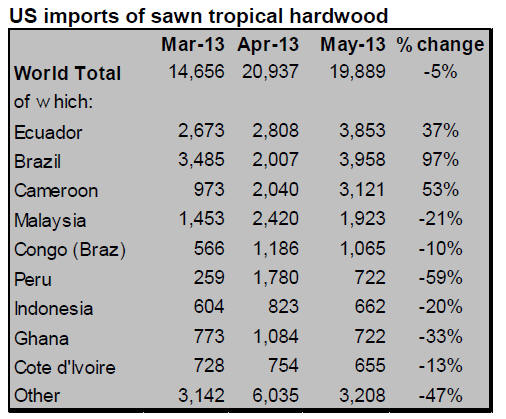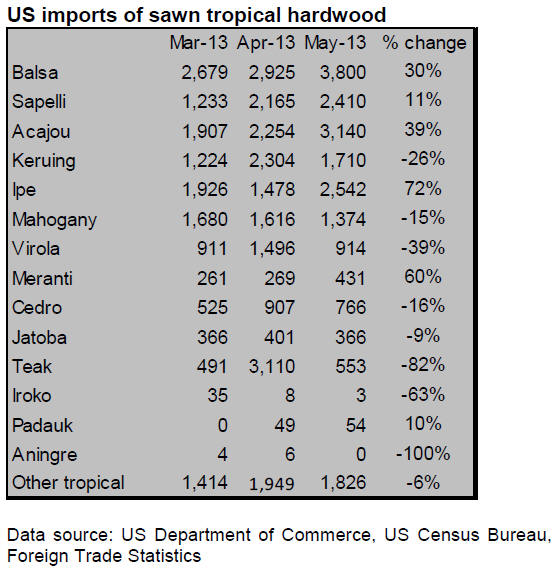|
Report
from
North America
Tropical sawn hardwood imports recovered in April
US tropical sawn hardwood imports declined by 5% in May compared to
levels in April. Imports of temperate sawn hardwood increased 22% in the
same time period.
Temperate sawn hardwood imports were 49,444 cu.m. in May, compared to
19,889 cu.m. of tropical sawnwood imports.
Tropical sawn hardwood imports from the US¡¯ three largest suppliers
(Brazil, Ecuador and Cameroon) increased in May, while shipments from
all other major sources were lower than in April.

Imports from Brazil almost doubled from April to 3,958 cu.m. (+19%
year-to-date). Ipe imports increased to 2,410 cu.m. No Virola imports
were reported in April, but 610 cu.m. were shipped in May.
Ecuador shipped 3,800 cu.m. of balsa in May, up from 2,808 cu.m. in
April, but US balsa imports remain below 2012 level.
Imports from Cameroon were 3,121 cu.m. in May (+2% year-to-date). Sapeli
shipments increased to 1,567 cu.m., while shipments of acajou d¡¯Afrique
almost tripled to 1,387 cu.m.
Malaysian shipments to the US were 1,923 cu.m. in May, down 21% from the
previous month (+1% year-to-date). The decline was mainly in keruing
shipments (1,593 cu.m.).


Turnaround in Canadian wood product manufacturing
Wood product manufacturing has exceeded growth in most other
manufacturing sectors, according to Statistics Canada.
In the last 12 months (June 2012 to May 2013) sales in the wood products
sector grew by 19.7% from the same period a year earlier.
Over the same period total manufacturing sales (excluding wood products)
declined by 1.1%.
The industry¡¯s recovery is mostly linked to growth in the US housing
market. Canadian sawmills and wood preservation companies increased
sales the most, driven by higher exports to the US.
Statistics Canada reports a 10.5% increase in wood prices over the past
year as a result of higher demand in the sawmill and wood preservation
industries.
The province of British Columbia has the largest wood product
manufacturing industry in Canada, accounting for one third of the
industry¡¯s national sales. While British Columbia was particularly hard
hit by the downturn in the US housing market, its industry is now the
fastest-growing in Canada.
Quebec is Canada¡¯s second largest wood product manufacturing province
with a more diverse industry, which includes processed products such as
millwork, windows and doors. However, the sectors benefiting most from
the US housing market recovery are also sawmills and wood preservation.
Mexico enforcing new phytosanitary regulations
Mexico¡¯s Secretariat of Environment and Natural Resources finalized
phytosanitary regulations for wood imports in March 2013, and the
revised regulations came into effect on July 2, 2013. The goal of the
new regulations is to better protect Mexico¡¯s forests from invasive
insects and other pests.
The US and several other countries (Argentina, Belize, Bolivia, Brazil,
Cameroon, Canada, Chile, China, Colombia, Congo, Costa Rica, Ecuador,
Germany, Spain, Fiji, the Philippines, France, Ghana, Guatemala,
Honduras, India, Indonesia, Italy, Malaysia, Nicaragua, Nigeria, Panama,
Peru, Russia, Taiwan, Uruguay and Venezuela) are allowed to export green
and air dried sawnwood to Mexico without having to prepare a pest risk
analysis.
All sawnwood needs to be bark free and have a phytosanitary certificate
which documents the treatment: heat treated or kiln-dried to 19% or
less, or fumigated with methyl-bromide.
The stricter regulations are expected to affect furniture manufacturers
and other importers in Mexico who rely on hardwood imports from the US
and other countries.
Updates on the regulations are available on the US Phytosanitary Export
Database:
https://pcit.aphis.usda.gov/PExD/faces/ViewPExD.jsp
¡¡
|